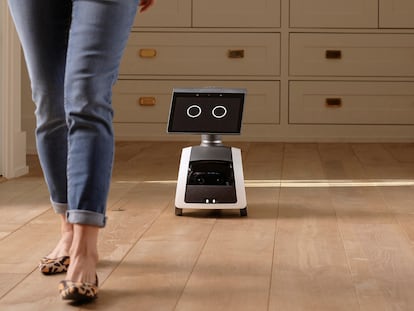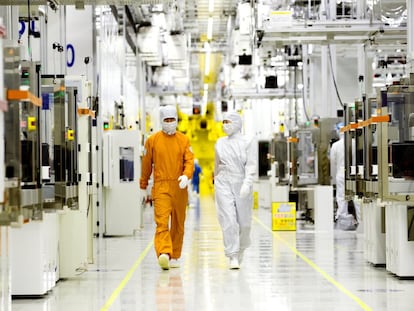A belt that warns if you eat too much and other experiments Samsung invests in to ensure their success
The technology company is promoting a fever-reducing device, insoles with sensors and a portable car charger
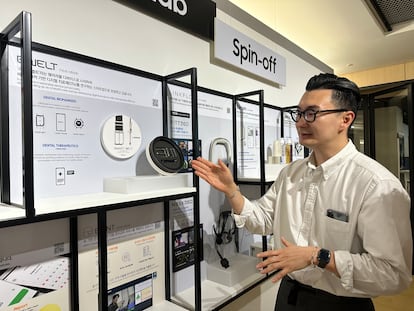

A belt that warns if you eat too much, a forehead cooler to lower fever or a scanner that helps sort fabrics for cleaning clothes. These are just some of the inventions that Samsung is supporting through its Creative Lab (C-Lab) innovation program. The tech giant certainly understands what success entails. The company started out selling fruit and fish more than 80 years ago and has evolved into a powerhouse that accounts for 20 percent of South Korea’s GDP. Now it is aiming to help several of its employees and external startups to achieve this success.
Since the inception of Creative Lab in 2012, the program has supported 391 projects initiated by the company’s employees and 475 by external startups. “In the early 2000s, Samsung Electronics created the C-Lab because it began to rapidly grow as a company and many startups, such as Facebook and Twitter, began to emerge in that decade and were expanding fast,” explains Jun Kim, employee of the public relations and strategy department of C-Lab’s creative development center. The South Korean brand has set itself a target of: “Innovating like the companies of Silicon Valley.”
“C-Lab creative” reads in colorful neon in front of a giant figure fashioned from plastic boxes. This is in Samsung’s digital city, in Suwon (South Korea), to which EL PAÍS was invited by the technology company. In an adjoining room, the brand displays some of the inventions in which it has invested. These include a machine for printing a temporary tattoo on the skin in seconds, a device that hangs on the neck and enables hands-free recording of everything going on around it, and a device that checks the scalp to prevent hair loss.
A smart belt
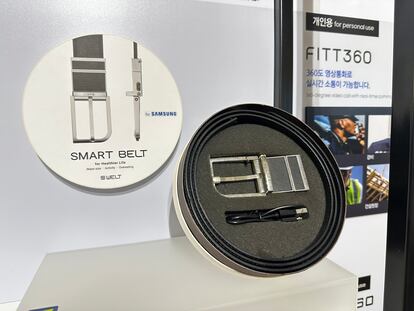
Another of the most curious inventions is a “smart belt for a healthier life.” It has been designed by the South Korean startup Belt and is intended to record information such as physical activity. “When you wear it, it sends health data to your cell phone. For instance, it alerts you if you’ve eaten too much and your belly is a little more bloated than usual or if it’s time to work out,” says Kim.
A device to reduce fever
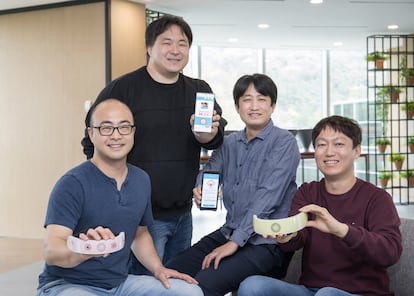
Ice Linker developed a smart cooler that automatically regulates the temperature of users who have a fever. “When worn on the head, it measures the patient’s body temperature at the temples and gradually reduces the temperature of the internal cooling plate in order to cool the user,” they explain at Samsung. The device monitors the patient’s condition in real time and can send notifications to the patient’s cell phone if the condition gets worse. The goal is that in the future it can also be used by outdoor workers and athletes.
A portable car charger
In 2016, Lee Hoon purchased an electric vehicle. He soon realized that there was a shortage of charging points in his area. As he recounts, he needed his neighbors’ consent to install new chargers. But he was out of luck. That’s when he thought of the following: “Can’t electric vehicles be charged with back-up batteries like cell phones?” That’s how he became the CEO of Evar, a portable car charger project. “When the driver sends the signal that he has parked the car at this location and wants to charge it here, the portable robot pops up and charges the car,” explains Kim.
A scanner that sorts clothes
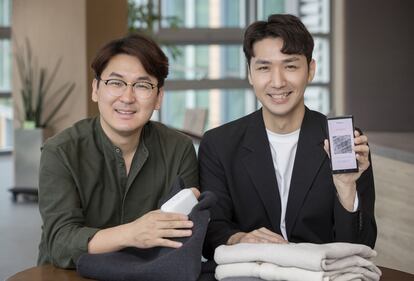
Scan & Dive is a scanner that examines clothing and recommends treatment options. The device can supposedly indicate the thickness and absorbency of a fabric and classify textiles such as cotton, polyester and rayon. “The solution can be used to automate garment sorting in laundry facilities and recycling centers and also to help fashion companies to inspect fabrics and make purchasing decisions,” according to Samsung.
Insoles with sensors
“Our feet occupy only 2% of the total body area yet support the rest of the body, 98%,” they explain at Salted. This company has developed insoles with sensors that capture data from the user’s foot, such as walking pattern, body weight imbalance and muscle movement. The user can consult all this data on an application and follow some advice to improve their body posture.
Sign up for our weekly newsletter to get more English-language news coverage from EL PAÍS USA Edition
Tu suscripción se está usando en otro dispositivo
¿Quieres añadir otro usuario a tu suscripción?
Si continúas leyendo en este dispositivo, no se podrá leer en el otro.
FlechaTu suscripción se está usando en otro dispositivo y solo puedes acceder a EL PAÍS desde un dispositivo a la vez.
Si quieres compartir tu cuenta, cambia tu suscripción a la modalidad Premium, así podrás añadir otro usuario. Cada uno accederá con su propia cuenta de email, lo que os permitirá personalizar vuestra experiencia en EL PAÍS.
¿Tienes una suscripción de empresa? Accede aquí para contratar más cuentas.
En el caso de no saber quién está usando tu cuenta, te recomendamos cambiar tu contraseña aquí.
Si decides continuar compartiendo tu cuenta, este mensaje se mostrará en tu dispositivo y en el de la otra persona que está usando tu cuenta de forma indefinida, afectando a tu experiencia de lectura. Puedes consultar aquí los términos y condiciones de la suscripción digital.
More information
Archived In
Últimas noticias
Rowan Atkinson tops Netflix at 70: ‘He’s as funny as ever’
Israeli recognition of Somaliland stirs up the Gulf
Tiger Woods turns 50: Will he continue playing on the PGA Tour or take a back seat?
The surreal journey of James Nnaji, the Barcelona youth player selected in the NBA Draft who ended up in the NCAA
Most viewed
- Oona Chaplin: ‘I told James Cameron that I was living in a treehouse and starting a permaculture project with a friend’
- Reinhard Genzel, Nobel laureate in physics: ‘One-minute videos will never give you the truth’
- Sinaloa Cartel war is taking its toll on Los Chapitos
- Why the price of coffee has skyrocketed: from Brazilian plantations to specialty coffee houses
- Chevy Chase, the beloved comedian who was a monster off camera: ‘Not everyone hated him, just the people who’ve worked with him’
